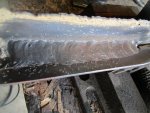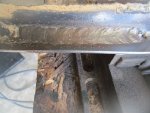Old Irish
Well-known member
- Messages
- 82
- Good Post Points
- 22
- Location
- The River Sticks
- Welder
- Lincoln SW200,PowerMig 180, A/C225 with rectifier, 2 Chinese plasma, stick, tig- 1-Chinese stick w/hot start&arc force and 1 Chinese 205A mig
mig is probably the easiest to learn but it is also the easiest to lay down a pretty bead only to have it just peel off of the base metal, it has a learning curve to just not as steep.


